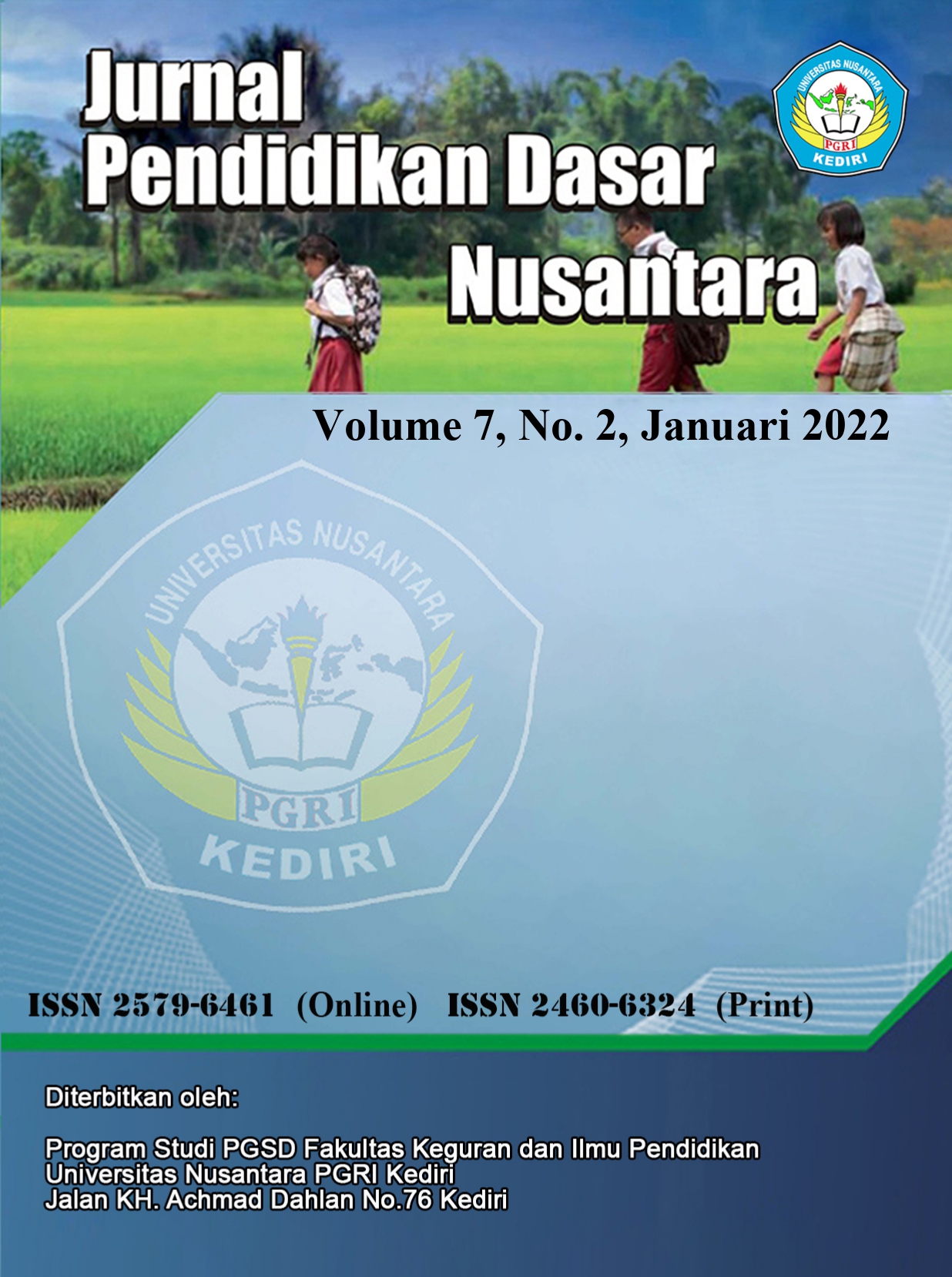Development of contextual teaching-based e-modules in grade V elementary school learning
DOI:
https://doi.org/10.29407/jpdn.v7i2.17051Keywords:
E-Module, Contextual Teaching.Abstract
The purpose of this study was to determine the development of e-modules based on Contextual Teaching in the fifth grade of elementary school learning. This research method uses research and development methods with the ADDIE approach. This research method uses research and development methods with the limits of expert judgment and practicality. Expert assessment is carried out on media, language, and material experts, while practicality with teachers and students. Data collection techniques use documentation and questionnaires, while data analysis techniques use percentages. Based on the results of the study showed that the E- Module Based on Contextual Teaching with an average of 3.70. Thus, it can be concluded that the development of Contextual Teaching-based E-modules in fifth grade elementary school learning is included in the valid or feasible category. From the results of the small group test and large group test, an average of 3.645 was obtained. Thus, it can be concluded that the feasibility of Contextual Teaching-based E-modules in class V elementary school learning is included in the practical or feasible category.
Downloads
References
Andriyanti, Windy. (2016). Model Contextual Teaching and Learning Dalam Pembelajaran Menulis Permulaan Di Kelas II Sekolah Dasar. Jurnal cakrawala pendas, vol 2,84.
Aditama. Kuntarto, E. (2017). Kefektifan Model Pembelajaran Daring dalam Perkuliahan Bahasa Indonesia Perguruan Tinggi . Indonesian Language Education and Literature,10.24235/ileal.v3i1.1820 , 99- 110.
Aprida Pane, M. D. (2017). Belajar dan Pembelajaran. Jurnal Kajian Ilmu-Ilmu Keislaman, 338.
Aprianti, Rika. (2015). Pengembangan E-Modul Berbasis Contextual Teaching and Learning (CTL) Dilengkapi Dengan Media Audio-Visual Untuk Meningkatkan Hasil Belajar Fisika Peserta Didik. E- Journal Vol 4, 137.
Ahrisya, Ledy. (2019). Pengaruh Model Pembelajaran Contextual Teaching and Learning (CTL) Terhadap Hasil Belajar Siswa Kelas V pada tema 9 subtema 1 di MI YPSM Al Manaar. E- Journal, vol 4, 338.
Daryanto. (2013). Menyusun Modul. Yogyakarta: Gava Media.
Depdiknas. (2008). Panduan Pengembangan Bahan Ajar. Jakarta: Direktorat Jendral Pendidikan Dasar dan Menengah.
Depdiknas. (2003). Pendekatan Kontekstual (Contextual Teaching and Learning CTL). Jakarta: Ditjen Dikdasmen.
Enriques, M. (2018). Students Perception On The Effectiveness of the Use of Edmodoasa Supplementary Tool for Learning. DLSU Research Congress.
Fausih, M. (2019). Pengembangan Media E-modul Mata Pelajaran Produktif Pokok Bahasan instalasi jaringan LAN (Local Area Network)' untuk siswa kelas XI Jurusan Teknik Komputer Jaringan di SMK Negeri 1 Labang Bangkalan Madura. J. Mhs. Teknol. Pendidik.,vol.5, 0.3 , 190.
Hamdani. (2010). Strategi Belajar Mengajar. Bandung: Pustaka Setia.
Herawati, S.N., & Muhtadi, A. 2018. Pengembangan Modul Elektronik (E-Modul) Interaktif Pada Mata Pelajaran Kimia Kelas XI SMA. Jural Inovasi Teknologi Pendidikan. 5(2).
Hidayah, Nurul. (2019). Pembelajaran Tematik Integratif di Sekolah Dasar. Jurnal Terampil: Keguruan dan Ilmu Tarbiyah , 36-37.
Kokom, K. (2013). Pembelajaran Kontekstual Konsep dan Aplikasi. Bandung: Reflika
Lefudin. (2014). Belajar dan Pembelajaran. Yogyakarta: Grup Penerbitan CV Budi
Utama. Majid, A. (2013). Perencanaan Pembelajaran. Bandung: PT Remaja Rosda Karya.
Murtono. (2017). Merencanakan dan Mengelola Model-Model Pembelajaran Inovatif. Ponorogo: Wade Group.
Mustaji. (2008). Pembelajaran Mnadiri. Surabaya: Unesa FIP.
Nurfadhilah, N. &. (2018). Kemampuan Penalaran Matematis Melalui Pembelajaran Contextual Teaching and Learning pada siswa SMP. Jurnal Elemen, vol 4(2) , 171.
Nurul Latifah, A. E. (2020). Pengembangan E-Modul Fisika Untuk Meningkatkan Kemampuan Berpikir Kritis Peserta Didik. JIPS:Jurnal Inovasi Pendidikan Sains, Vol.1 no.1 , 1-7.
Prastowo, A. (2011). Panduan Kreatif Membuat Bahan Ajar Inovatif. Yogyakarta:
DIVA Pres. Purwanto, dkk. (2007). Pengembangan Modul. Jakarta: PUSTEKKOM Depdiknas.
Riduwan. (2015). Dasar-Dasar Statistik. Bandung: Alfabeta.
Riyana. (2012). Media Pembelajaran. Jakarta: Direktorat Jenderal Pendidikan Islam Kementrian Agama RI.
Rusman, D. (2013). Model-model Pembelajaran Mengembangkan Profesionalisme Guru. Jakarta: Rajawali Pers.
Sanjaya, W. (2006). Strategi Pembelajaran Berorientasi Standar Proses Pendidikan. Jakarta:
Kencana. Soimin, A. (2014). Model Pembelajaran Inovatif Dalam Kurikulum 2013. Yogyakarta: Ar-Ruz Media. Solikin, Imam. (2019). Pengembangan Fitur Notifikasi e-modul Pada Program Studi Manajemen Informatika. Jurnal SIMETRIS, Vol. 10 No.1 , 190.
Sugiyono. (2016). Metode Penelitian Kuantitatif, Kualitatif, dan R&D. Bandung: Alfabeta.
Sugiyono. (2019). Metode Penelitian Pendidikan (Kuantitatif, Kualittif, Kombinasi, R&D dan Penelitian Pendidikan. Bandung: Alfabeta.
. (2009). Mendesain Model Pembelajaran Inovatif-Progresif. Jakarta: Kencana.
Zain, S. B. (2006). Strategi Belajar Mengajar. Jakarta: Rineka Cipta.
Downloads
Published
Issue
Section
License
Authors who publish with this journal agree to the following terms:
- Copyright on any article is retained by the author(s).
- The author grants the journal, the right of first publication with the work simultaneously licensed under a Creative Commons Attribution License that allows others to share the work with an acknowledgment of the work’s authorship and initial publication in this journal.
- Authors are able to enter into separate, additional contractual arrangements for the non-exclusive distribution of the journal’s published version of the work (e.g., post it to an institutional repository or publish it in a book), with an acknowledgment of its initial publication in this journal.
- Authors are permitted and encouraged to post their work online (e.g., in institutional repositories or on their website) prior to and during the submission process, as it can lead to productive exchanges, as well as earlier and greater citation of published work.
- The article and any associated published material is distributed under the Creative Commons Attribution-ShareAlike 4.0 International License

































